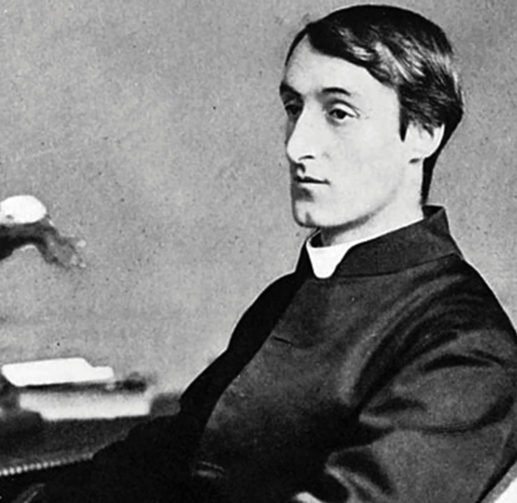‘I am so happy, I am so happy,” said Gerard Manley Hopkins, S.J., as he was dying in Dublin on June 8, 1889. As rich and resonant as any words in his poems, these words offer a multilayered commentary on his life and reputation. In 1889 he was happy to go to God as an unknown poet; in 2015 he enjoys worldwide fame as a major poet in the company of Donne, Milton, Keats and Eliot. How did this happen?
Gerard Hopkins was born on July 28, 1844, in the London suburb of Stratford, Essex, the oldest child of nine in a comfortable Church of England family. His father, Manley Hopkins, owned a London firm that insured ships against shipwreck. But Stratford was soon industrialized, and when Gerard was 8, the family moved to Hampstead, a quiet, leafy London suburb. Young Gerard was a happy boy who loved to climb trees, joined in family prayers and wrote schoolboy poems. He went up to Oxford University in 1863, made many new friends, was a brilliant student of the classics and wrote more poems, including his first sonnets. Like all Oxford students, he went to Church of England services, but he gradually grew uncertain about his religion. He read, thought and prayed, talked with the famed convert John Henry Newman (later a cardinal) and became a Roman Catholic in 1866. In 1867 he won a “first”—Oxford’s highest degree—in Greek and Latin classics, then went off to begin his life.
At Oxford Hopkins wanted to be both a painter and a poet, and after his conversion he also considered the Catholic priesthood. For eight months he taught at Newman’s school in Birmingham—the Oratory School—then, deciding to be a priest, he became a Jesuit in 1868. As a novice in London he learned Jesuit life and prayer, then studied philosophy in Lancashire and theology at St. Beuno’s College in North Wales. The first flashes of his poetic genius shone out at St. Beuno’s in 1875, when he wrote his great shipwreck ode, “The Wreck of the Deutschland,” and later 11 brilliant sonnets about nature and God. In 1877 he was ordained a priest at St. Beuno’s and at the age of 33 became Father Hopkins.
For seven years he worked in Jesuit schools and parishes in England and Scotland, writing poems about the environment, about his students and parishioners (like the Liverpool blacksmith “Felix Randal”) and about the Blessed Virgin Mary. He wrote lively sermons too. Once in Liverpool he compared the Holy Spirit to a cricket player urging a teammate, “Come on, come on!” As Paraclete, he told the congregation, the Holy Spirit “cheers the spirit of man...calling him on...: This way to do God’s will, this way to save your soul, come on, come on!” The Holy Ghost as a cricket player? Hopkins had a most lively sense of humor!
In 1884 he was sent to Dublin as a professor of Greek in the new University College on St. Stephen’s Green and as an examiner in the Royal University. He made many good friends in Ireland and enjoyed his teaching and his students but twice a year grew exhausted from grading hundreds of examination papers from all over the country. For months in 1885 he suffered from deep depression, even failing to contact God in prayer and wondering if he was losing his mind. He screamed out his pain in anguished—and brilliant—sonnets like “I wake and feel the fell of dark” and “No worst, there is none.” After a few months he recovered from his depression, but in 1889 he contracted typhoid fever and died at the age of 44, seven weeks before his 45th birthday. People remembered him as a warm friend and fine priest, but he was unknown as a poet.
Who was this man they remembered? Who was Gerard Hopkins as a person? Hopkins stood about 5’3” tall, had a high-pitched voice, a lively sense of fun and was nicknamed “Hop.” As a boy he joined in school games and loved to sketch trees and their shapes. As a Jesuit he prayed, hiked, swam, climbed mountains, wrote poems and once hurt his wrist arm-wrestling. He was always close to his family and made warm, lifelong friends at Oxford, with fellow Jesuits and with Irish families; at St. Beuno’s, a Jesuit later wrote, he was “the most popular man in the house.” For recreation he visited art exhibitions and old churches, enjoyed concerts and took vacations with his family, with Oxford friends and with fellow Jesuits, in Switzerland, Holland, England, Wales, Scotland and Ireland. He also composed small pieces of music but was not very good at it.
Hopkins’s major passions were beauty, nature and the environment, language and poetry, art and music, family and friends, England, the saints and God. He was mostly a happy Jesuit, though he suffered from a lifelong “melancholy” (his word) that helped bring on that depression in Dublin. As a young man he worried excessively about sin but later learned the more positive Jesuit way of finding God in all things, and in the poem “God’s Grandeur” he wrote, “The world is charged wíth the grándeur of God”—God is in the world like an electric charge ready to spark out—“pfft, pfft”—to show God’s presence. He loved Christ deeply, especially as really present in the Eucharist, and in a sermon he delivered in Liverpool he celebrated Christ as a “Hero” for all humans. His intellectual hero was a medieval philosopher, Duns Scotus, who celebrated individuality and selfhood. Hopkins even saw a unique selfhood in every tree and every bird! He had a strong sense of his own self, too, and though recognizing the dangers of fame, he was highly self-confident as a poet, even writing in his last poem that though he was losing his inspiration, his technique remained perfect: my “hand at work [is] now never wrong.” Today, 179 of his poems survive, most in English and a few in Greek, Latin and Welsh, but very few were published during his lifetime. Hopkins died in 1889 as an unknown poet.
Who Is Hopkins Now?
Today Gerard Manley Hopkins is a poet of worldwide fame, and the story is fascinating. His poems were not published until 1918, 29 years after his death, when his Oxford friend Robert Bridges edited Poems of Gerard Manley Hopkins for Oxford University Press. Only 750 copies of the book were printed, though, and just 180 were sold in the first year. Hopkins remained unknown.
But in the 1920s and ’30s, a new way of reading poetry—called the New Criticism—was being developed in England and the United States. Its practitioners rejected the old ways of literary critics—studying a writer’s life, sources, intentions and effect on readers—and studied the poem itself through a “close reading” of the text: its words, images, sounds and form. The New Critics admired Hopkins’s vivid language and rich sound—his “texture”—and showed his brilliance to readers, poets and fellow critics. Gradually, Hopkins became famous and over the decades influenced such poets as W. H. Auden, Dylan Thomas, John Berryman, Robert Lowell, Denise Levertov, Sylvia Plath and the Nobel laureate Seamus Heaney. He also inspired some 500 musical works by Aaron Copland, Samuel Barber, Benjamin Britten, Ned Rorem, Sir Michael Tippett and others. Many books study him—commentaries, critical studies, biographies—and countless articles. There are three journals devoted to him: The Hopkins Quarterly, an international journal (of which I am co-editor), published in Philadelphia, and Hopkins Research and Nondum, both published in Japan.
Hopkins is also memorialized in art. A grand but little-known tribute is a huge bas-relief in the United Nations’ Palais des Nations in Geneva, which the United Kingdom presented to the League of Nations in 1938 as the Lord Cecil Memorial. The bas-relief is called “The Creation of Adam”; around Adam’s reclining figure the great English sculptor Eric Gill carved five lines from the opening stanza of “The Wreck of the Deutschland.” In 1975 Hopkins was honored in Westminster Abbey’s famed Poets’ Corner with a large floor stone of black marble bearing the tribute “Priest & poet/ ‘Immortal diamond’” carved below his name. In 2004 the Scottish Parliament building in Edinburgh was formally opened, and on its “Canongate Wall” 24 quotations were carved in stone, one bearing the last four lines of Hopkins’s environmental poem “Inversnaid” about a waterfall at Loch Lomond. Two monuments honor him at Regis University in Denver and in Monasterevin, Co. Kildare, Ireland. Smaller memorials also celebrate him: in London a “Blue Plaque” decorates the wall of Manresa House, Roehampton, where he lived and studied; and in Dublin, a plaque at the door of No. 86 St. Stephen’s Green, the original building of University College Dublin, records three famous figures who worked there: “John Henry Newman, Rector; Gerard Manley Hopkins, Professor of Greek; James Augustine Joyce, Student.” Notable company for a once-unknown poet!
The 1989 centennial of Hopkins’s death brought him new international fame. The centennial day itself, June 8, was celebrated in London, Oxford, Dublin, Washington, D.C., and at Loch Lomond. Major exhibitions were mounted by Oxford University, by University College Dublin and by the University of Texas at Austin, with smaller exhibitions at St. Beuno’s, at Hopkins’s birthplace in Stratford, Essex, at Gonzaga University in Spokane, Wash, and in a travelling exhibition in North Wales. Academic events honored him in England, Wales, Ireland, Italy and the United States; and lectures celebrated him in France, England, Wales, Canada, the United States, Paraguay, the Philippines and Japan.
Today, 25 years after his centennial, Hopkins’s poems still inspire music, new books still proliferate, and scholars of many religions—or none—teach, translate and write about him in countries as diverse as Israel, Sweden, Poland, Italy, France, England, the United States, Mexico, Korea and Japan. Book-length translations of his poems are published in Japanese, Korean, Dutch, French, German, Polish, Spanish, Italian and Hebrew, and a Russian translation is now underway. He has had novels written about him, notably Ron Hansen’s Exiles (2008); three one-man plays portray his life; and actors like Richard Burton and Richard Austin have recorded his poems. Every year, Regis University in Denver holds an international Hopkins Conference, and the Hopkins Society of Ireland sponsors a Hopkins Festival in Co. Kildare. Oxford University Press currently is publishing a new scholarly edition of everythingHopkins wrote, in eight large volumes.
A few final signs of Hopkins’s current fame complete the picture. Just before Christmas 2009, a theater company in Santa Fe, N.M., performed 30 Hopkins poems spoken, sung and danced by 35 people; the two performances drew audiences of several hundred. In 2011, at the funeral of the actress Elizabeth Taylor and following her wish, an actor read Hopkins’s poem “The Leaden Echo and the Golden Echo.” In 2013, just after his election, Pope Francis told an interviewer (Am., 09/30/2013) that he “liked Gerard Manley Hopkins very much.” And with a touch of whimsy, I add that two pubs memorialize Hopkins. In England, his birthplace of Stratford has a pub named the “Goldengrove” (a rich word from his poem “Spring and Fall”) with Hopkins displays inside, and in Ireland, Monasterevin has a pub called “The Manley Hopkins.” Not every poet—or every Jesuit priest—has two pubs named for him!
All these details tell a larger story: the man unknown at his death in 1889 is alive and famed today throughout the world.








